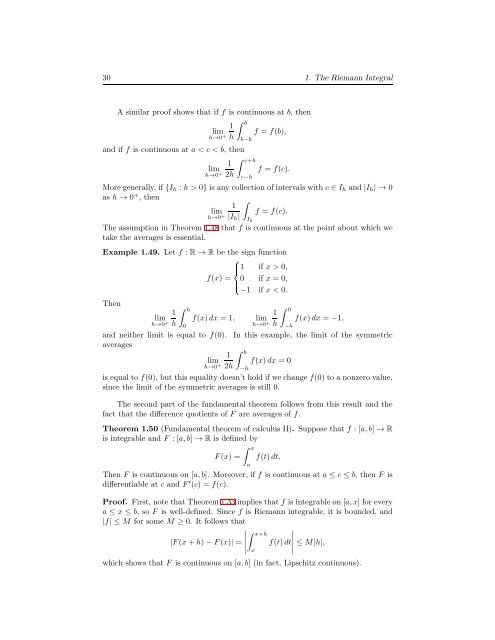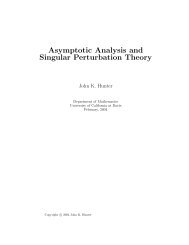The Riemann Integral
The Riemann Integral
The Riemann Integral
Create successful ePaper yourself
Turn your PDF publications into a flip-book with our unique Google optimized e-Paper software.
30 1. <strong>The</strong> <strong>Riemann</strong> <strong>Integral</strong><br />
A similar proof shows that if f is continuous at b, then<br />
∫<br />
1 b<br />
lim f = f(b),<br />
h→0 + h b−h<br />
and if f is continuous at a < c < b, then<br />
∫<br />
1 c+h<br />
lim f = f(c).<br />
h→0 + 2h c−h<br />
More generally, if {I h : h > 0} is any collection of intervals with c ∈ I h and |I h | → 0<br />
as h → 0 + , then<br />
∫<br />
1<br />
lim f = f(c).<br />
h→0 + |I h | I h<br />
<strong>The</strong> assumption in <strong>The</strong>orem 1.48 that f is continuous at the point about which we<br />
take the averages is essential.<br />
Example 1.49. Let f : R → R be the sign function<br />
⎧<br />
⎪⎨ 1 if x > 0,<br />
f(x) = 0 if x = 0,<br />
⎪⎩<br />
−1 if x < 0.<br />
<strong>The</strong>n<br />
∫<br />
1 h<br />
∫<br />
1 0<br />
lim f(x)dx = 1, lim f(x)dx = −1,<br />
h→0 + h 0<br />
h→0 + h −h<br />
and neither limit is equal to f(0). In this example, the limit of the symmetric<br />
averages<br />
∫<br />
1 h<br />
lim f(x)dx = 0<br />
h→0 + 2h −h<br />
is equal to f(0), but this equality doesn’t hold if we change f(0) to a nonzero value,<br />
since the limit of the symmetric averages is still 0.<br />
<strong>The</strong> second part of the fundamental theorem follows from this result and the<br />
fact that the difference quotients of F are averages of f.<br />
<strong>The</strong>orem 1.50 (Fundamental theorem of calculus II). Suppose that f : [a,b] → R<br />
is integrable and F : [a,b] → R is defined by<br />
F(x) =<br />
∫ x<br />
a<br />
f(t)dt.<br />
<strong>The</strong>n F is continuous on [a,b]. Moreover, if f is continuous at a ≤ c ≤ b, then F is<br />
differentiable at c and F ′ (c) = f(c).<br />
Proof. First, note that <strong>The</strong>orem 1.33 implies that f is integrable on [a,x] for every<br />
a ≤ x ≤ b, so F is well-defined. Since f is <strong>Riemann</strong> integrable, it is bounded, and<br />
|f| ≤ M for some M ≥ 0. It follows that<br />
∫ x+h<br />
|F(x+h)−F(x)| =<br />
f(t)dt<br />
∣ ∣ ≤ M|h|,<br />
which shows that F is continuous on [a,b] (in fact, Lipschitz continuous).<br />
x
















